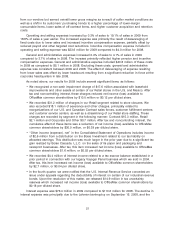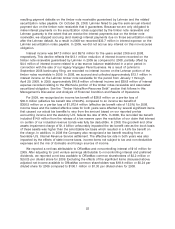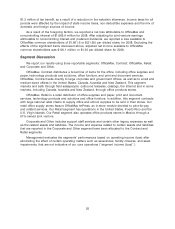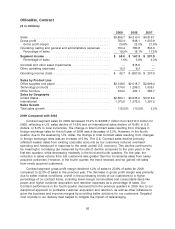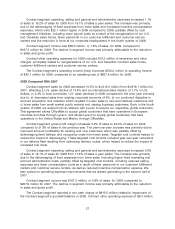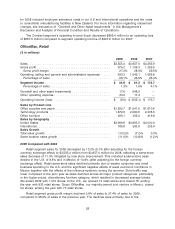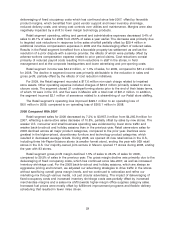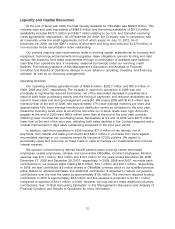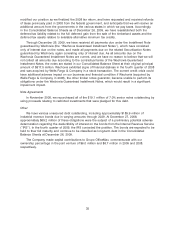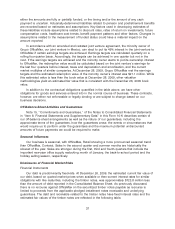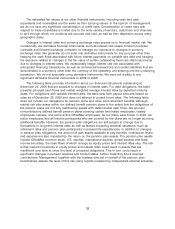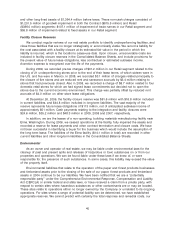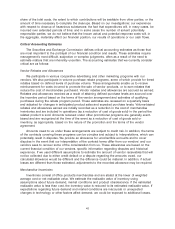OfficeMax 2009 Annual Report Download - page 35
Download and view the complete annual report
Please find page 35 of the 2009 OfficeMax annual report below. You can navigate through the pages in the report by either clicking on the pages listed below, or by using the keyword search tool below to find specific information within the annual report.Liquidity and Capital Resources
At the end of fiscal year 2009, the total liquidity available for OfficeMax was $999.6 million. This
includes cash and cash equivalents of $486.6 million and borrowing availability of $513.0 million
(availability includes $473.3 million and $39.7 million relating to our U.S. and Canadian revolving
credit agreements, respectively). As of December 26, 2009, the Company was in compliance with
all covenants under the credit agreements, both of which expire on July 12, 2012. As of
December 26, 2009, we had $297.1 million of short-term and long-term debt and $1,470 million of
non-recourse timber securitization notes outstanding.
Our primary ongoing cash requirements relate to working capital, expenditures for property and
equipment, technology enhancements and upgrades, lease obligations, pension funding and debt
service. We expect to fund these requirements through a combination of available cash balance,
cash flow from operations and, if necessary, seasonal borrowings under our revolving credit
facilities. The following sections of this Management’s Discussion and Analysis of Financial
Condition and Results of Operations discuss in more detail our operating, investing, and financing
activities, as well as our financing arrangements.
Operating Activities
Our operating activities generated cash of $358.9 million, $223.7 million and $70.6 million in
2009, 2008 and 2007, respectively. The increase in cash from operations in 2009 was due
principally to significantly reduced inventories, net of the associated decrease in payables as a
result of both lower purchasing activity and the timing of payments, and reduced receivables as a
result of lower sales and strong management oversight. We ended 2009 with $143.8 million less
inventory than at the end of 2008, with approximately 17% lower average inventory per store and
approximately 15% lower average inventory per distribution center as compared to the prior year.
Clearance inventory levels were at an all time low while our in-stock levels were high. Accounts
payable at the end of 2009 were $68.5 million lower than at the end of the prior year, primarily
reflecting lower merchandise purchasing levels. Receivables at the end of 2009 were $27.5 million
lower than at the end of the prior year, reflecting both sales declines in the Contract segment and a
modest improvement in days sales outstanding compared to the prior year period.
In addition, cash from operations in 2009 includes $71.0 million of tax refunds, net of
payments, from federal and state governments and $45.7 million in proceeds from loans against
accumulated earnings in our company-owned life insurance (COLI) policies. We expect to
periodically repay and re-borrow on these loans in order to manage our investments and minimize
interest expense.
We sponsor noncontributory defined benefit pension plans covering certain terminated
employees, vested employees, retirees, and some active OfficeMax, Contract employees. Pension
expense was $14.1 million, $4.2 million and $10.0 million for the years ended December 26, 2009,
December 27, 2008 and December 29, 2007, respectively. In 2009, 2008 and 2007, we made cash
contributions to our pension plans totaling $6.8 million, $13.1 million and $19.1 million, respectively.
In 2009, we also contributed 8.3 million shares of OfficeMax common stock to our qualified pension
plans. Based on actuarial estimates, this additional contribution is expected to reduce our pension
contributions over the next five years by approximately $100 million. The minimum required funding
contribution in 2010 is approximately $3.8 million and the expense is projected to be $7.1 million
compared to expense of $14.1 million in 2009. However, we may elect to make additional voluntary
contributions. See ‘‘Critical Accounting Estimates’’ in this Management’s Discussion and Analysis of
Financial Condition and Results of Operations for more information.
31


